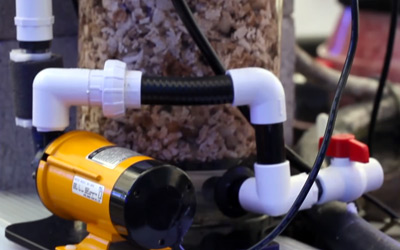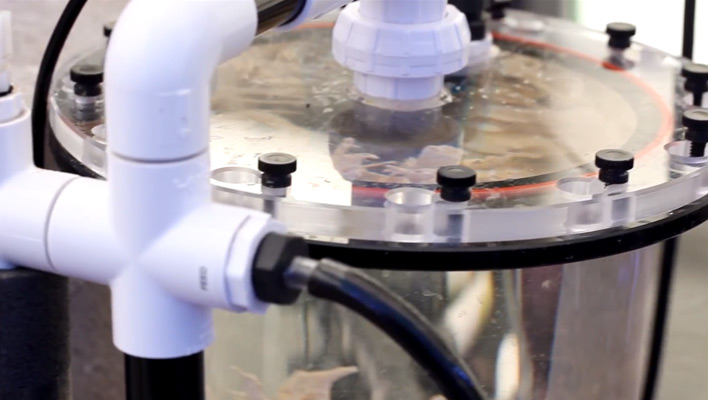A hobby like reef keeping has its fair share of intimidating technologies. I suppose it doesn’t help to call certain technologies sterilizers, fractionators, or reactors, which further instills a sense of complexity. One such device is the calcium reactor, and while I am a big proponent of having as simple a system as possible, this component has proven its worth over the years.
So what does a calcium reactor do?
A calcium reactor maintains calcium and alkalinity in the reef aquarium and keeps the pH of the water high and stable. In a reef aquarium, maintaining calcium and alkalinity is one of the most important tasks, especially when stony corals are concerned. Even with no stony corals present, many organisms, ranging from calcareous algae to crustaceans and mollusks, rely on a consistent supply of both of these elements for growth and optimal health.
How does a calcium reactor maintain calcium and alkalinity?
A calcium reactor works by dissolving a calcium carbonate medium and slowly dripping it back into the reef tank. When calcium carbonate breaks down, calcium ions and bicarbonate ions are released. Calcium is taken up by a countless number of organisms, while bicarbonate serves as a biochemical buffer that stabilizes the pH of the water.
The calcium carbonate medium doesn’t just break down on its own. In normal tank conditions, calcium carbonate is a solid. In order to dissolve it into calcium ions and bicarbonate ions, the water has to become more acidic. The pH of natural salt water hovers around 8.3 to 8.5. For a calcium reactor to function, the pH running through the medium has to be closer to 6.8 to 7.2. To achieve a slightly acidic environment, we bubble carbon dioxide into the reaction chamber. When carbon dioxide is introduced into water, carbonic acid is formed and thus you get a lower pH over time.
The device itself is actually quite simple. It consists of a main reaction chamber, a circulation pump, a feed pump, and a carbon dioxide dosing system (tank, regulator, bubble counter).
Main reaction chamber
 The main reaction chamber holds the calcium carbonate medium to be dissolved. There is some debate occasionally on the type of medium used. I don’t get caught up too much in claims that a certain medium is “better” than another, but there is one important thing I look for in medium, and that is chunkiness. For a reactor to work well, the water has to re-circulate easily and to allow bubbles of CO2 to make their way to the top of the reaction chamber. Over time, as the medium breaks down, it tends to get a little sludgy, so it is important that you don’t start with a medium that is so fine that it turns into mud once it dissolves.
The main reaction chamber holds the calcium carbonate medium to be dissolved. There is some debate occasionally on the type of medium used. I don’t get caught up too much in claims that a certain medium is “better” than another, but there is one important thing I look for in medium, and that is chunkiness. For a reactor to work well, the water has to re-circulate easily and to allow bubbles of CO2 to make their way to the top of the reaction chamber. Over time, as the medium breaks down, it tends to get a little sludgy, so it is important that you don’t start with a medium that is so fine that it turns into mud once it dissolves.
Feed pump
There is a feed pump to send water to the reactor and an effluent line for the water to drip out and back into the reef tank. The feed pump’s sole purpose is to keep positive water pressure going to the reactor. Without it, the water would just re-circulate in the reaction chamber and never make it back into the tank. The effluent line drains out the solution in a controlled fashion from the reactor and to the tank. While it is technically possible to control the flow of water going in and coming out of the reactor from the feed pump, most people control the flow with a valve on the effluent line. Either a tubing valve or a pinch valve works well; however, pinch valves tend to have fewer maintenance issues long term because, unlike needle valves, saltwater does not flow through them.
Circulation pump
The calcium reactor requires heavy turnover within the main reactor chamber to mix in the CO2. Typically, the circulation pump is significantly larger than the feed pump, as it is the one that must do almost all the heavy lifting.
CO2 regulator, bubble counter, and tank
In order for the calcium reactor to function, it must lower the pH inside the main reaction chamber to dissolve calcium carbonate. This is done with the controlled introduction of carbon dioxide gas. On every calcium reactor, there is a bubble counter that connects the carbon dioxide gas line to the reactor. Most reef aquarists look to introduce about one bubble per second into the reactor. The amount of carbon dioxide gas coming from the tank is controlled with a precision needle valve.
If everything works according to plan, the slow trickle of effluent from the calcium reactor will contain a healthy dose of calcium and trace elements vital to the health and wellbeing of many of the tank’s invertebrates. Additionally, the effluent drip will contain bicarbonate, which acts as a buffering solution that works to raise the tank’s pH.
The beauty of calcium reactors is they work slowly and gently. Once they reach their peak performance, they do a wonderful job of maintaining calcium and alkalinity very consistently. If you are having issues balancing calcium and alkalinity in your reef tank, check out a calcium reactor. It may be the answer to your prayers.




Hey, Guys, I would also recommend Galassi & Ortolani here, they have been making special valves since years. The have a wide range of products, comprising: diaphragm valves, pinch valves, butterfly valves, ball valves, gate valves, check valves & pneumatic actuators. Here is their website: http://www.galassiortolani.com/category/pinch-valves/
Thank you so much for your input on this topic. I stand quite explained. Clean,simple and lucid.
Looking forward for more from a treasure chest as you.
Great article gave me some new ideas what do you think about two part calcium dosing ?
Thanks and keep up the good work
Don